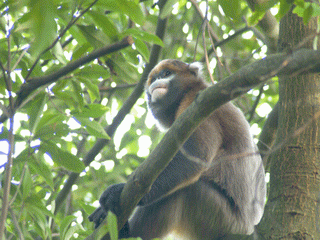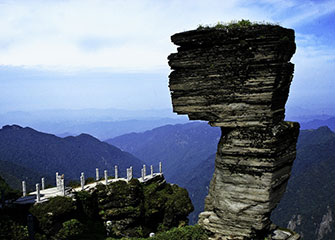search for a Trip

Fanjingshan National Nature Reserve was established in 1978 under the approval of the government of Guizhou Province. In 1986, it was promoted to a national nature reserve and, in the same year, it was included in the 'Man and Biosphere' Protection Network of UNESCO.
Located at the juncture of the three counties of Yinjiang, Jiangkou and Songtao in northeastern Guizhou Province, Mt. Fanjingshan is one of the main peaks of Wuling Mountain Range. The whole reserve covers an area of 567 sq kilometers (219 sq miles), dominated by the primitive vegetation.
Fanjingshan National Nature Reserve is a treasure-house of plants and wildlife. The reserve is rich in plant resources and 80% of the conservation area is covered with virgin forest and other plants. There are about 795 families of plants and 1,955 species, including 14 families and 19 species of gymnosperms, 460 families and 1,155 species of spermatophyte and 123 families of fungi. Some plants are rare, such as the dove flowers which grow only in this region. Due to the influence of the sub-tropical alpine monsoon climate, the distribution of vegetation is vertically zonal. The plants vary from the evergreen broad leaf forest to deciduous trees.


The favorable climate and lush vegetation make the reserve an ideal habitat for wild fauna. The number of wild animal species identified and documented has reached over 800. The diversified fauna include 68 species of mammals, 191 species of birds, 41 species of reptiles and 34 species of amphibians, respectively accounting for 13.6%, 6.2%, 10.9% and 12.2% of the national total animal population.
Among these species, some are rare and endangered. The Guizhou golden monkeys can be seen only in this region and are on the edge of extinction, hence a national treasure and protected species. Other species like clouded leopard, South China Tiger, pangolin and antelope are also important national protected animals.
The biodiversity in the reserve is unparalleled elsewhere at the same latitude. It is the one of the best-preserved subtropical forest ecosystems in China. The verdant mountain, the clear water and the diversified wildlife constitutes a unique environment.
The religious significance adds a splendor to the charm of Fanjingshan. It is a holy site for Buddhism and their adherents. As a saying goes, it is nature that shaped the fantastic scenery of Fanjingshan, and it is Buddhists that made the mountain well-known. 'Fanjing' in Chinese, means a pure land for Buddhists. The serene environment allows visitors to feel their minds purified.
Its established reputation as a sacred land of Buddhism can be traced back to the 16th century. In the mountain there are numerous Buddha temples, of which the temples worshiping Maitreya and Sakyamuni are the most famous. Each year, thousands of adherents flock there to worship.
Fanjingshan has three main peaks, the 'Old Golden Summit', 'Fenghuang (means phoenix) Summit', and 'New Golden Summit'. There are over 8,000 stone steps from the foot to the summit. Climbing along the winding mountainous road to the summit is a rewarding pleasure.
The 'Hongyun Golden Summit' is fabulous for the sea of cloud and mist. The colorful halo emerging in the sky around the summit is a most appealing wonder. The halo is like a rainbow and viewed as a sign of auspiciousness.
Related Tours:
China Attractions Guide
- Anhui Attractions
- Beijing Attractions
- Chongqing Attractions
- Fujian Attractions
- Gansu Attractions
- Guangdong Attractions
- Guangxi Attractions
- Guizhou Attractions
- Hainan Attractions
- Henan Attractions
- Hongkong Attractions
- Hubei Attractions
- Hunan Attractions
- Inner Mongolia Attractions
- Jiangsu Attractions
- Jiangxi Attractions
- Manchuria Attractions
- Ningxia Attractions
- Qinghai Attractions
- Shaanxi Attractions


